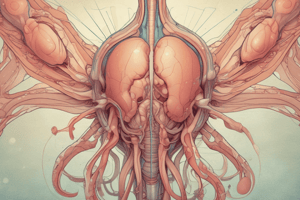Podcast
Questions and Answers
Where do sperm mature before traveling through the vas deferens?
Where do sperm mature before traveling through the vas deferens?
- Urethra
- Prostate gland
- Epididymis (correct)
- Seminal vesicles
During mating, where are sperm and seminal fluid mixed together before ejaculation?
During mating, where are sperm and seminal fluid mixed together before ejaculation?
- Ovaries
- Seminal vesicles and prostate gland (correct)
- Cervix
- Fallopian tubes
Where does fertilization typically occur in the female reproductive system?
Where does fertilization typically occur in the female reproductive system?
- Vagina
- Cervix
- Uterus
- Fallopian tubes (correct)
What is the final outcome when a zygote implants itself in the uterus?
What is the final outcome when a zygote implants itself in the uterus?
Why is understanding the reproductive system important in animals?
Why is understanding the reproductive system important in animals?
Where does the fertilized egg begin to divide and grow after implantation?
Where does the fertilized egg begin to divide and grow after implantation?
What is the process of producing offspring through sexual or asexual means called?
What is the process of producing offspring through sexual or asexual means called?
Which system in animals is responsible for facilitating sexual reproduction?
Which system in animals is responsible for facilitating sexual reproduction?
What is the outcome of the fusion of two nuclei from the sperm and egg in sexual reproduction?
What is the outcome of the fusion of two nuclei from the sperm and egg in sexual reproduction?
Which part of the male reproductive system is responsible for producing sperm?
Which part of the male reproductive system is responsible for producing sperm?
What allows sexual reproduction to create offspring with a diverse range of traits?
What allows sexual reproduction to create offspring with a diverse range of traits?
Which of the following is NOT a part of the male reproductive system?
Which of the following is NOT a part of the male reproductive system?
Flashcards are hidden until you start studying
Study Notes
Reproduction in Animals
Reproduction is a crucial process in the life of all organisms, including animals. It involves the production of offspring through sexual or asexual means, ensuring the survival of species from one generation to another. In animals, reproduction can occur sexually through mating, where two individuals produce genetically distinct offspring, or asexually, where the offspring is a clone of the parent. This article provides an overview of the various aspects of reproduction in animals, focusing on sexual reproduction, the reproductive system, and the process of fertilization.
Sexual Reproduction
Sexual reproduction is the most common method of reproduction in animals. It involves the fusion of two nuclei from the sperm and the egg, which results in the formation of a diploid zygote. This process is also known as fertilization. Sexual reproduction allows for genetic variation and the creation of offspring with a diverse range of traits, increasing the chances of survival in changing environments.
Reproductive System
The reproductive system in animals is designed to facilitate the process of sexual reproduction. In most animals, this system is divided into two main parts: the male reproductive system and the female reproductive system.
Male Reproductive System
The male reproductive system consists of the testes, epididymis, vas deferens, seminal vesicles, prostate gland, and urethra. The testes produce sperm, which are stored in the epididymis until they mature. The sperm then travel through the vas deferens and are mixed with seminal fluid from the seminal vesicles and prostate gland before being ejaculated through the urethra during mating.
Female Reproductive System
The female reproductive system includes the ovaries, fallopian tubes, uterus, cervix, and vagina. The ovaries produce eggs, which are released into the fallopian tubes during ovulation. The eggs travel through the fallopian tubes, where they may be fertilized by sperm. If fertilization occurs, the zygote implants itself in the uterus, where it develops into an embryo and eventually a fetus.
Fertilization
Fertilization is the process by which the sperm and egg combine to form a zygote. This occurs in the fallopian tubes, and the fertilized egg then travels to the uterus, where it implants in the uterine lining. The fertilized egg begins to divide and grow, eventually developing into an embryo and ultimately a fetus.
In conclusion, reproduction in animals is a complex process that involves various anatomical and physiological changes. Through sexual reproduction, animals ensure the continuation of their species, with offspring inheriting a diverse range of genetic traits. Understanding the reproductive system and the process of fertilization can offer valuable insights into the biology of animals and their evolution.
Studying That Suits You
Use AI to generate personalized quizzes and flashcards to suit your learning preferences.




